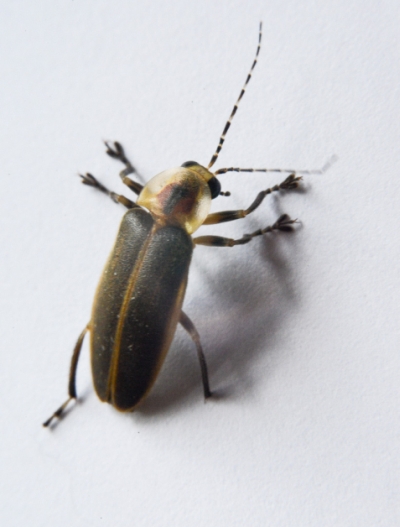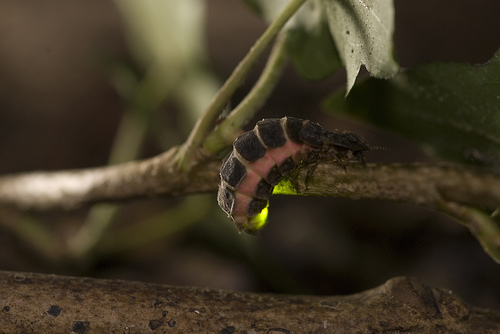Scientifically, fireflies are classified under Lampyridae, a family of insects within the beetle order Coleoptera, or winged beetles. While most fireflies are characterized by their use of bioluminescence to attract mates and communicate with others in their species, not all insects within the firefly family produce light. Some communicate using pheromones, a sort of insect perfume. There are thousands of firefly species spread across temperate and tropical zones all over the world. In New England alone, you might see twenty or thirty species. But all fireflies are classified under five main subfamilies. LAMPYRIDINAE (SUBFAMILY)PhotininiIf you live in North America, these are the fireflies you're probably most familiar with. Not all fireflies in this subfamily light up, but those that do are generally divided into many closely related species. Photinus fireflies tend to be the most common of this group; about half an inch long, these produce yellow-green light. The most common amoung this group is Photinus pyralis, or the common eastern firefly. This is most likely what most people will see in their backyards at night. Below is a picture of Photinus pyralis, the most common firefly species you will see at night. Photinus carolinus is the synchronous firefly species that produces the beautiful synchorized displays in the Appalachian mountains of the US. They occur in 4 US states with Elkmont, Tennessee having the largest populations. They are 8-12.5mm long, and produce a yellow-green synchronized flash in order to signal to females. These fireflies are found in hardwood forests near creeks or rivers. They can be seen in the third week of May to the third week in June starting at 9:30pm eastern time in the US. CratomorphiniPyractomena fireflies produce a yellow-amber flicker that looks a bit like a spark from a campfire. PhausisPhausis reticulata also known as blue ghost fireflies. These tiny fireflies are common throughout the southeastern US and are known as the “blue ghost” because they do not flash but glow with an eerie blue or green light. Females of the blue ghost are pale yellow or white in color and lack wings (right in photo below). Males do have wings and can fly (left in photo below). Since they have not be studied extensively little is still known about them and their habits. PleotominiPleotomus fireflies are relatively uncommon. Both Pleotomus pallens and Pleotomus nigricans occur in the southwest. Scientists are still discussing whether they should be classified as one species or two distinct species. They are also found in Mexico. Pleotomus davisii is found in Tennessee and Kentucky rarely. The following is an example of Pleotomus sp. larvae. At this stage the larvae glow periodically throughout the night. They are found after dark crawling along the ground in the leaf litter looking for things to eat. The most common time to find them is after a big rain storm preceding a dry period. These particular larvae were found on the river bottom of the Devil's river in Texas during May 2015. LampyriniMicrophotus is a small genus of nocturnal glowworm fireflies occurring throughout the southwestern United States and adjacent parts of Mexico. They are found in discontinuous pinyon-juniper and juniper-oak habitats. Females have no wings and are larva-like in appearance. Both males and females possess paired photic organs on the terminal abdominal sections. Females emit intermittent glows to attract males. Males, while capable of emitting weak glows or flickers, apparently do not use bioluminescence in sexual communication. LamproceriniTenaspis belongs to a much larger neotropical fauna of fireflies. There is only one species, Tenaspis angularis (Gorham), in the US. These fireflies are primarily found in the Gulf states of the US. Nothing is known about the larval form of this genus. PHOTURINAE (SUBFAMILY)PhoturinaePhoturis fireflies are larger—almost an inch long—and produce a darker green light. They're very difficult to distinguish from Photinus from their light alone, even for other fireflies; female Photuris often mimic mating flashes from female Photinus fireflies to attract and eat Photinus males. Because of this, Photuris species are sometimes called “femme fatale” fireflies. Photuris versicolor is a part of a species complex of 17 named species, with an additional 30 or more yet to be named by Jim Lloyd (L. Faust personal communication). Photuris versicolor occurs from the NE of the US, Texas, Utah, Colorado, California, and into parts of Mexico. They are large fireflies, typically 10-15 mm, with females 15-18 mm. They are early season fireflies occuring in late May to late June. There is a predominant diagonal strip on the shoulder of each wing cover. This is one of the predatory fireflies or agressive mimics of other fireflies flash patterns. Females are predatory while males are not. Females are erratic, highly variable flashers, capable of many types of flashes.  Photuris frontalis is part of a species complex that includes Photuris congener. They are a forest firefly. These are smaller fireflies between 9-11mm. They occur across the southern US into Texas. They have a unique flash pattern that varies based on location, habitat, and temperature. They are recognized as the only synchronous firefly of the North American genus Photuris. LUCIOLINAE (SUBFAMILY)LuciolinaeThis is the largest subfamily of fireflies, with member species scattered throughout Eurasia, Europe, East Asia, and Australia. The fireflies within this subfamily all produce light—and flash rather than emit a continuous glow. Here are a few genera of note within this group. Peroptyx. Species within this group are mainly found in tropical Asia. Groups of fireflies will synchronize their flashes until thousands are all flashing to the same rhythm, producing a stunning display. Luciola. These fireflies are sometimes known as “Japanese fireflies,” although they're also found in Asia and more rarely in southern Europe and Africa. In Japanese traditional culture, they are believed to represent the souls of the dead.
Luciola lusitanica Also known as the Portuguese firefly. Males of this species are the only ones that fly, females do not fly. Females are usually found on the ground or in vegetation, they are also bigger than the males. While males flash, females emit a long or continuous yet unsteady yellow glow from one light organ in it's abdomen. One advantage that non-flying female fireflies have is they are often able to lay more eggs than flying females. More energy that normally would be used for flying can be reserved and put towards laying more eggs. This enables a better chance of survival for more of their offspring. CYPHONOCERINAECyphonocerinaePollaclasis This subfamily of fireflies includes two genera that live in North America and Eurasia. They're notable because scientists believe they are the most primitive species of fireflies in existence. One genus within this group displays very weak light, while the other does not light up at all. The following is male Pollaclasis bifaria, found in Mississippi. OTOTETRINAE (SUBFAMILY)OtotetrinaeScientists haven't decided whether this group should be classified as fireflies; while they share many characteristics of other species, members of the group Ototetrinae don't emit light. They're considered very primitive forms of fireflies, and live primarily in Eurasia and North America. LAMPYRIS (GENUS)LampyrisSometimes referred to by taxonomists as a “catch-all” subfamily classifying fireflies that don't quite fit into other groups, the species in this genus live generally in more temperate northern regions of the world. The group contains both flashing and continuous-glow fireflies. Some larvae species within this group climb trees to feed on snails and bugs. Lampyris is a genus of firefly within this subfamily found primarily in Britain, and they thrive in old-growth grasslands in soil with high concentrations of limestone and chalk. Only the males fly; the females are larviform, and only they glow. Females crawl onto blades of grass and low vegetation at dusk and emit a yellow-green continuous light to attract mates. Their vernacular name is “glow worm.” 
萤火虫分类下的Lampyridae,在甲虫的鞘翅目昆虫的一个家庭,或者有翅膀的昆虫。虽然大多数萤火虫的特征是它们利用生物发光来吸引配偶并与它们的物种中的其他人交流,但萤火虫家族中并非所有的昆虫都能产生光。
世界各地有数千种萤火虫分布在温带和热带地区。仅在新英格兰,你可能会看到二十或三十种。但所有的萤火虫分五个主要亚科下。
lampyridinae(亚科)
荧光酶基因与 如果你住在北美洲,这些萤火虫可能是你最熟悉的。并不是所有萤火虫都在这个亚科中发光,但是那些萤火虫通常被划分为许多紧密相关的物种。
Photinus萤火虫往往是最常见的这组;约半英寸长,这些产生黄绿色的光。最常见的在这组Photinus pyralis,或普通东方萤火虫。这是最有可能的是大多数人会看到在他们的后院,晚上。下面的图片是Photinus pyralis,最常见的萤火虫物种,你会看到在晚上。
的Photinus carolinus是同步的萤火虫在美国阿巴拉契亚山脉产生美丽的synchorized显示。它们发生在美国的4个州和埃尔克蒙特、田纳西有最多的人口。他们8-12.5mm长,产生黄绿色同步闪光以信号的女性。这些萤火虫存在于小溪或河流附近的阔叶林中。他们可以看到在可能的第三周第三周六月开始在东部时间9:30在美国。
cratomorphini pyractomena萤火虫产生黄色琥珀色闪烁,看起来有点像营火火花。
phausis phausis reticulata亦称蓝光萤火虫。这些微小的萤火虫在美国东南部很常见,被称为“蓝幽灵”,因为它们不会闪光,但会发出奇怪的蓝光或绿光。蓝色幽灵的女性颜色为浅黄色或白色,缺少翅膀(右图)。雄性有翅膀,能飞(左图)。由于他们没有得到广泛的研究,人们对他们和他们的习惯还知之甚少。
pleotomini pleotomus萤火虫是比较少见的。Pleotomus pallens和pleotomus黑棘皮病发生在西南。科学家们仍在讨论它们是否应该归类为一种或两种不同的物种。它们在墨西哥也有发现。Pleotomus davisii被发现在田纳西和肯塔基很少。
以下是一个例子pleotomus sp.幼虫。在这个阶段,幼虫在夜间周期性地发光。它们被发现在黑暗中沿着落叶的地面爬行寻找食物。最常见的找到它们的时间是在旱季之前的一场大暴雨之后。这些特殊的幼虫是2015年5月在德克萨斯魔鬼河的河底发现的。
lampyrini microphotus是夜间萤火虫萤火虫发生在美国西南部和墨西哥附近地区的一个小属。他们在连续pinyon-juniper和Juniper橡木栖息地。
雌性没有翅膀,外表上象幼虫。男性和女性在终末腹部都有成对的光器官。雌性发出间歇性的发光以吸引雄性。男性,而能发出微弱发光或闪烁,显然不在使用生物性传播。
lamprocerini Tenaspis属于一个更大的新热带区系的萤火虫。只有一种,Tenaspis angularis(戈勒姆),在美国。这些萤火虫主要存在于美国的Gulf州。这一属的幼虫形态一无所知。
photurinae(亚科)
photurinae Photuris萤火虫大几乎一英寸长,产生暗绿色的光。他们分辨来自北美从他们的光很难独善其身,甚至其他的萤火虫;雌性Photuris经常模仿交配雌性Photinus萤火虫闪烁吸引男性吃萤火。正因为如此,Photuris物种有时被称为“蛇蝎美人”的萤火虫。
福图利斯云芝是一种复杂的17个命名的物种的一部分,一个额外的30个或更多的未被命名的Jim Lloyd(L. Faust个人通信)。福图利斯云芝时从美国,德克萨斯,犹他,科罗拉多,加利福尼亚,东北,和墨西哥部分地区的。他们是大的萤火虫,通常10-15毫米,雌性15-18毫米。它们是五月下旬到六月下旬出现的早期季节萤火虫。每个翼盖的肩部有一条明显的对角条。这是一个积极的捕食萤火虫或模仿其他萤火虫闪光模式。女性是掠夺性的,而男性不是。女性是不稳定的,高度可变的闪光灯,具有多种类型 |
